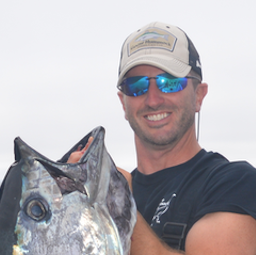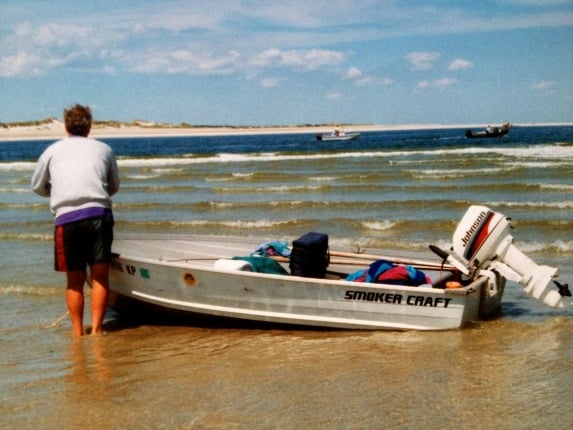
Usually starting sometime in early or mid-August, peanut bunker arrive along the Cape Cod and Massachusetts coastlines.
The peanut bunker schools will remain plentiful in the region throughout September, and often well into October and November.
Last week I shared this report about shallow-water peanut bunker blitzes. In today's report, I would like to share with you information and video about peanut bunker blitzes out deep.
More...
Fishing With My Dad
Back on August 28th, I picked my dad up at 5:15am for a morning trip in our little 12 foot boat. Not long after launching, we spotted birds working in about 30 feet of water, so we headed over for a closer look.

My dad loves fishing and being on the water. When I was a little kid, my dad would take me fishing all the time on our 12 foot boat (pictured below) so this trip brought back good memories for both of us.

Pictured above is my dad with our original 12 foot boat. The boat is beached on the east bar in Barnstable Harbor during low tide.
On the morning of August 28th we enjoyed flat calm conditions with bass and bluefish feeding on peanut bunker all around us. I had a lot of fun during this trip capturing underwater and aerial images of the feeds.
You can get a preview of the action by clicking play below!
*Members of MFCC can watch an additional 6 minutes of deep-water striper blitz footage by clicking here.
Interesting Observations
Some interesting observations I made during the trip with my dad include:
Because we were in a boat, I did not pay too close attention to the tide. The feeds pretty much lasted all day long, again probably because it takes so much effort and energy on the stripers' part to catch enough peanut bunker to "get full".

We were using white Albie Snax soft plastics when casting to surface feeding fish. We also used live eels in hopes of enticing a bigger bass from the bottom. The eels worked well but unfortunately we did not catch any monster bass as we had hoped.
In Conclusion
I had a great time this past August filming peanut bunker blitzes, and I learned a lot about how bass and bluefish like to hunt. Even better, I was able to fish with my dad, as well as other friends and family members.
What do you think? Have you made it out fishing recently? What are you seeing out there right during now? Please let me know by commenting below!
*PS-Members of MFCC can watch an additional 6 minutes of deep-water striper blitz footage by clicking here.
Tight lines!





Thanks Ryan. The videos are great. I love the one when the bass bump the camera! Great to see you and your dad fishing together! Special time for both if you I am sure!
I was out this morning on a south facing beach and saw large “linear clouds” of very small peanut bunker swimming past me against the current at the end of the incoming tide. There were a few others fishing as well. None if us got fish. No sign of stripers or blues at this particular beach. No birds working, no fish breaking. It seems like there is a ton of bait around, South side and Bay side. Do you feel there is more bait around this year? or am I just more aware of my surroundings! Also, as we have seen in many of your videos, sometimes stripers are just not feeding. I have to figure out when feeding time is!
It’s always good to get out fishing with Jake! We have had many awesome fishing experiences together, whether it be from the 12 foot boat, our 19′ Carolina Skiff (which we had when I was a teenager) or our 21 foot Miss Loretta.
I do agree there is a ton of bait around, but I’m in position to judge whether it’s more or less bait than in years past. I feel September is a very special month for this area. The Cape is a plentiful place for fish, birds and ocean dwelling animals. September/October is also when the population of great white sharks usually peaks. There always seems to be a lot of life around the coastline this time of year, as long as we don’t get a hurricane.
If you found a place with bait, then I bet it will only be a matter of time until the area is discovered by predators. Thing is there are lots of areas jam packed with bait right now, so the bass, bluefish and albies have plenty of places to choose from.
Good luck out there this week! ?
The student, has become my teacher. Dad
What are you talking about? That transition occurred many years ago. LOL. ?
Looking forward to our next trip. Give mom a hug for me!
I have often read that underneath a surface feed of small bass or bluefish there will often be much larger bass slurping up the pieces that sink down from the feeding frenzy above. The problem is to get a bait or lure through the smaller fish to the bigger bass below. One article provided a possible solution. Surround a mackerel chunk or peanut bunker on a hook with a small brown paper sandwich bag. Some weight on the line may be necessary as well. Drop the combination in the water and let it sink down below the commotion on the surface. Allow some time for the bag to become soaked and soggy, then yank your rod to rip the bait out of the bag. Your bait is now down where the bigger fish are holding without being picked off as it sinks through the layer of smaller fish. I would assume that some degree of experimentation would be needed as far as time for the bag to become water logged and how hard to yank to get the bait free without taking it off the hook. Also some custom cutting of the bag to get it through the first layer and then be able to get it free quickly, maybe presoak the bag? This would be an interesting technique to try and might yield impressive results!
I have never heard of that technique before, but hey, it could be worth a try! At the least it would make for an interesting video. ?